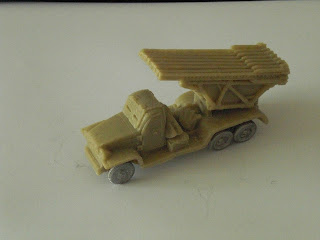I have found a rule-set called "FUBAR" recently (download:
http://thegamesshed.wordpress.com/2010/06/17/fubar-one-page-sfmodern-rules/). And there is this rule: The active player can try to activate a unit. If he misses the probe initiative will change and the opponent could try to activate his units. Within a turn the right to act randomly changes.
I had to think about that for a longer moment.
As I mentioned before, we are playing a self-made tabletop game in our wargaming group and precisely this rule was discussed one year ago.
If I unstand the rule right, two things will happen:
- Not all units get activated in a turn (this can be quite frustrating!)
- It is not possible to plan a strategy (this can be more frustrating!)
Do you know the game "Don´t get angry!" (german: "Mensch ärgere Dich nicht!")? It is the same effect: You have to roll a 6 on a 1D6 to "activate" your meeple at the beginning. If your are not lucky, you cannot act in your turn. Meanwhile your opponents are playing - hey, don´t get angry! *gg*
Besides that it can be very frustrating to be not allowed to act because of a lack of fortune, it makes no sense to plan an attack or a long term strategy. At any point of the turn your plan is doomed for failure if the opponent has more luck than you. Is this fair? IMHO not! Is this a strategic wargame? IMHO not!
Maybe I should not demonize this rule, maybe "there´s more than meets the eye with you." Sorry, had to lend this quote by Sam Witwicky *bg*
What about a little justification?
New rule: The active player can try to activate a unit. He makes his turn until he will miss the activation probe. The second player gets his chance now. And so on. Main changement: A unit that could not be activated at first try, can be activated later. The unit is not lost in this turn. If one player used all of his troops the other player can act freely till the end of the turn.
What will happen?:
- All units get used in one turn
- You can plan a longer strategic proceeding but sometimes you have to react on things your opponent is doing.
Disadvantage: The rolls of dice for initiative cost too much time.
Maybe even better: Both players roll a dice (1D10 or 1D12). The result is the sum of the roll and their initiative value (INI). The more points one player is above the result of his opponent the more units he can use till the next initiative probe is needed.
Example:
Player A with INI=5 rolls his dice and the outcome is 9. Result: 14.
Player B with INI=3 rolls his dice and the outcome is 5. Result: 8.
Player A can act with 6 (14-8=6) of his units until the next initiative probe decides who will act next.
Hm, just thinking aloud *gg*
What do YOU mean?
In my imagination it could be worth to try this variation out.
Let´s do it! ;-)














